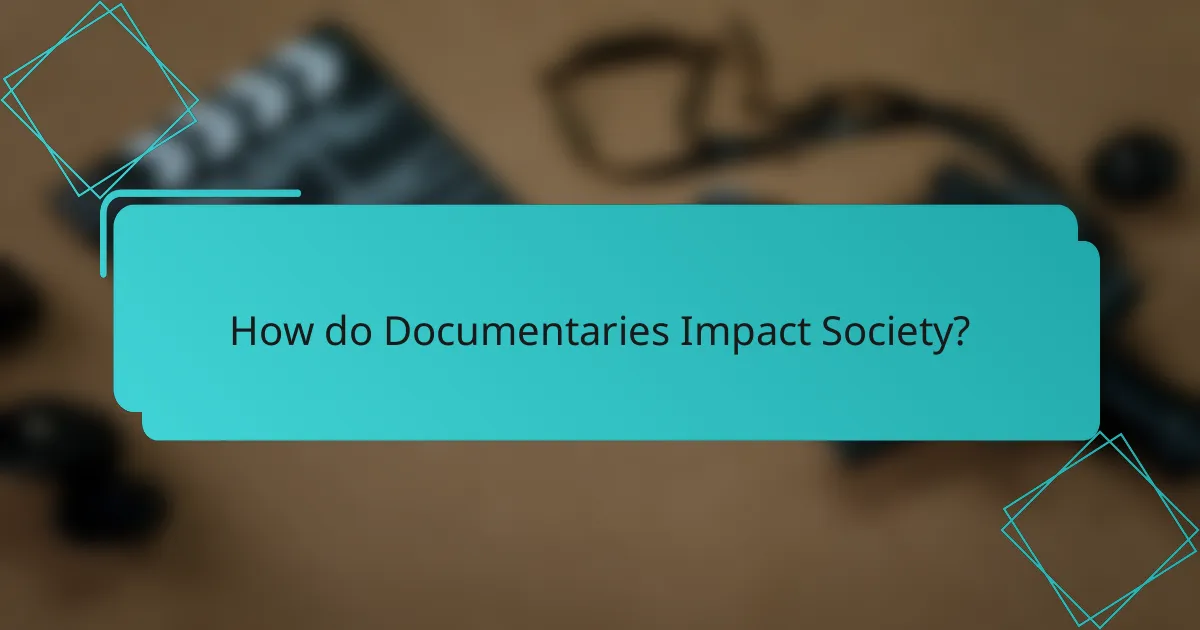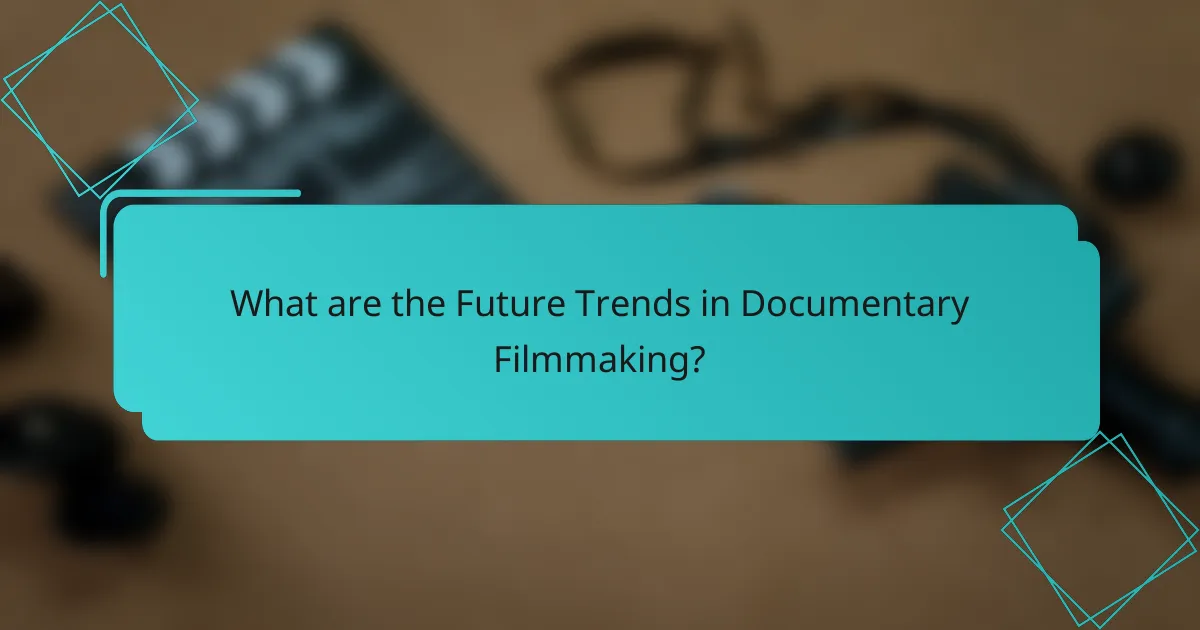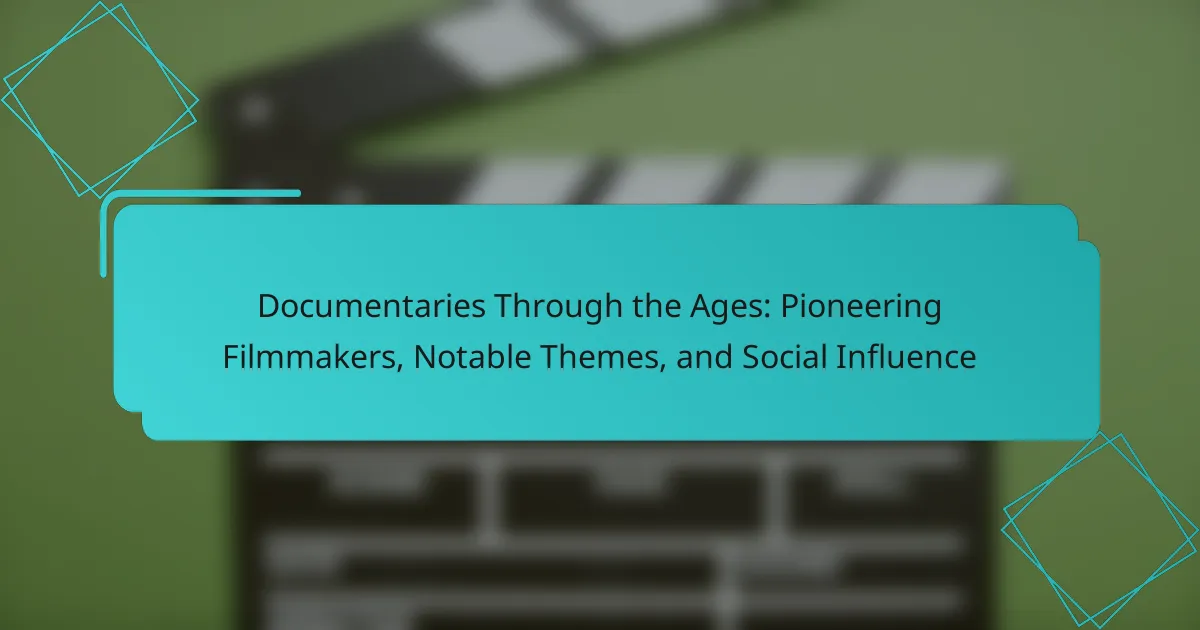Documentaries are non-fiction films that document reality for educational purposes and historical preservation. This article explores the evolution of documentaries, highlighting key figures such as Robert Flaherty and significant works like “An Inconvenient Truth” and “13th,” which have influenced public opinion and social change. It discusses the role of documentaries in capturing cultural narratives and raising awareness about critical issues, as well as emerging trends in the genre, including virtual reality, interactive formats, and data-driven storytelling. The article also examines the impact of crowdfunding on documentary funding and the growing focus on social justice themes in contemporary filmmaking.

What are Documentaries and Their Historical Significance?
Documentaries are non-fiction films that document reality for the purposes of instruction, education, or maintaining a historical record. They serve to inform audiences about various subjects, ranging from social issues to nature and history. Documentaries gained prominence in the early 20th century, with notable examples like Robert Flaherty’s “Nanook of the North” in 1922. This film is often credited as one of the first feature-length documentaries, showcasing the life of an Inuit family.
The historical significance of documentaries lies in their ability to provide insight into different cultures and events. They often serve as a tool for social change by raising awareness about critical issues. Documentaries have influenced public opinion and policy, as seen in films like “An Inconvenient Truth,” which brought climate change to the forefront of global discourse.
Additionally, documentaries preserve historical narratives and personal stories that might otherwise be lost. They contribute to the collective memory of societies by capturing moments in time. Overall, documentaries play a crucial role in educating the public and shaping cultural understanding.
How have documentaries evolved over time?
Documentaries have evolved significantly from their inception in the late 19th century. Early documentaries, such as “Workers Leaving the Lumière Factory” (1895), showcased real-life events with minimal narrative. In the 1920s, filmmakers like Robert Flaherty introduced a more artistic approach with “Nanook of the North,” blending storytelling with factual content. The 1960s saw the rise of direct cinema, emphasizing observational techniques and real-time events, as seen in “Don’t Look Back” (1967) by D.A. Pennebaker.
The advent of television in the 1970s brought documentaries into mainstream media, allowing broader audiences to engage with topics like social issues and politics. The 1990s and 2000s introduced the use of digital technology, enhancing production quality and accessibility. Documentaries like “Super Size Me” (2004) showcased personal narratives that resonated with viewers.
In recent years, streaming platforms have further transformed the landscape, making documentaries more diverse and globally accessible. The evolution reflects changing societal interests and technological advancements, illustrating the genre’s adaptability and relevance.
What were the earliest forms of documentary filmmaking?
The earliest forms of documentary filmmaking include actualities and travelogues. Actualities are short, unedited films that capture real-life events or situations. They emerged in the late 19th century, with examples like the Lumière brothers’ “Workers Leaving the Lumière Factory” from 1895. Travelogues showcase different cultures and places, often narrated by filmmakers. Early examples include “The Great Train Robbery” and films by Robert Flaherty. These formats laid the groundwork for modern documentary practices by emphasizing real-life storytelling.
How did technological advancements influence documentary styles?
Technological advancements significantly influenced documentary styles by enhancing visual storytelling capabilities. The introduction of lightweight cameras in the 1960s allowed filmmakers to capture real-life events more spontaneously. This led to the rise of direct cinema, characterized by unobtrusive filming techniques. Additionally, the development of digital editing software revolutionized post-production processes. Filmmakers could now manipulate footage more efficiently and creatively. The advent of high-definition and 4K video technology improved image quality, making documentaries visually more engaging. Furthermore, online streaming platforms expanded distribution channels, allowing diverse documentary styles to reach wider audiences. These advancements collectively transformed the documentary genre, fostering innovation and accessibility.
What role do pioneering filmmakers play in documentary history?
Pioneering filmmakers are crucial in shaping documentary history. They introduce innovative techniques and storytelling methods. Their work often challenges societal norms and highlights important issues. For instance, Robert Flaherty’s “Nanook of the North” (1922) set a standard for ethnographic documentaries. Similarly, John Grierson, who coined the term “documentary,” emphasized the genre’s role in social reform. These filmmakers paved the way for future generations by blending art and factual storytelling. Their contributions laid the foundation for documentaries as a respected form of cinema.
Who are some of the most influential documentary filmmakers?
Some of the most influential documentary filmmakers include Frederick Wiseman, Barbara Kopple, and Errol Morris. Frederick Wiseman is known for his observational style and films like “Titicut Follies.” Barbara Kopple gained acclaim for “Harlan County, USA,” which highlighted labor struggles. Errol Morris is recognized for his innovative techniques and films such as “The Thin Blue Line.” These filmmakers have significantly shaped the documentary genre through their unique storytelling approaches and impactful subject matter.
What unique contributions did these filmmakers make to the genre?
Many pioneering filmmakers made unique contributions to the documentary genre. Robert Flaherty is known for creating the first feature-length documentary, “Nanook of the North,” which established narrative storytelling in documentaries. John Grierson coined the term “documentary” and emphasized the importance of social commentary in films. His work, such as “Drifters,” focused on the lives of working-class individuals. D.A. Pennebaker introduced direct cinema, allowing audiences to experience events as they unfolded. His film “Don’t Look Back” showcased the rawness of real-life events. Barbara Kopple’s “Harlan County, USA” highlighted labor struggles and the impact of documentary on social activism. Each filmmaker’s approach and themes shaped the evolution of the genre and influenced future documentary styles.
What notable themes have emerged in documentaries through the ages?
Notable themes that have emerged in documentaries through the ages include social justice, environmentalism, and historical events. Social justice documentaries often address issues like civil rights and inequality. Environmentalism has gained prominence with films highlighting climate change and conservation efforts. Historical events are frequently explored to provide context and insight into significant moments. Other themes include cultural identity, personal narratives, and political commentary. Each of these themes reflects societal concerns and interests at different times. Documentaries have evolved to encompass these themes, influencing public perception and awareness.
How do social and political issues shape documentary themes?
Social and political issues significantly shape documentary themes by influencing the topics filmmakers choose to explore. Documentaries often reflect societal concerns and political climates. For instance, during the civil rights movement, filmmakers highlighted racial injustice and activism. This thematic focus raised awareness and sparked dialogue. Similarly, documentaries addressing climate change emphasize environmental issues and their political implications. Filmmakers use these themes to educate audiences and provoke thought. Historical events, like wars or social movements, also inspire documentary content. These films often serve as a platform for marginalized voices. Thus, social and political issues remain central to the development of documentary themes.
What are some recurring themes in modern documentaries?
Recurring themes in modern documentaries include social justice, environmental issues, and personal identity. Social justice themes often highlight inequality and activism. Documentaries like “13th” explore systemic racism in the U.S. Environmental issues are frequently addressed, as seen in “Our Planet,” which focuses on climate change. Personal identity themes delve into individual experiences and cultural backgrounds. Films such as “Won’t You Be My Neighbor?” examine the impact of influential figures on society. These themes resonate with audiences and reflect contemporary societal challenges.

How do Documentaries Impact Society?
Documentaries impact society by educating viewers and raising awareness about critical issues. They provide factual narratives that can influence public opinion and inspire social change. Documentaries often highlight underrepresented voices and perspectives. This can lead to increased empathy and understanding among audiences. For instance, “13th,” directed by Ava DuVernay, examines racial inequality in the United States. It sparked conversations about systemic racism and criminal justice reform. Research shows that documentaries can change viewers’ attitudes and encourage activism. A study by the University of Southern California found that watching documentaries increased participants’ willingness to engage in social issues. Thus, documentaries serve as powerful tools for societal impact.
What is the relationship between documentaries and social change?
Documentaries play a significant role in driving social change. They raise awareness about critical issues and inspire action among viewers. Documentaries often highlight marginalized voices and underrepresented communities. For instance, “An Inconvenient Truth” brought global attention to climate change, influencing public policy and individual behavior. Research shows that documentaries can alter perceptions and motivate civic engagement. A study by the University of California found that viewers of social issue documentaries were more likely to participate in activism. This illustrates how documentaries can effectively bridge the gap between information and action, fostering a more informed and engaged society.
How have documentaries raised awareness on critical issues?
Documentaries have raised awareness on critical issues by presenting factual narratives that inform and engage audiences. They highlight social injustices, environmental crises, and health concerns through real-life stories. Films like “An Inconvenient Truth” have educated viewers about climate change, influencing public opinion and policy. Documentaries often feature expert interviews, statistics, and personal testimonies to reinforce their messages. For instance, “13th” explores systemic racism in the U.S. criminal justice system, prompting discussions and activism. The visual nature of documentaries makes complex topics accessible and relatable. Their ability to evoke emotional responses can motivate viewers to take action. Overall, documentaries serve as powerful tools for social change and awareness.
What examples showcase documentaries influencing public opinion?
“An Inconvenient Truth” is a prominent example of a documentary influencing public opinion on climate change. Released in 2006, it features former Vice President Al Gore presenting scientific evidence of global warming. The film sparked widespread discussion and increased awareness about environmental issues. Following its release, public concern for climate change rose significantly. Surveys indicated a marked increase in individuals recognizing climate change as a serious issue. The documentary’s impact led to policy discussions and initiatives aimed at addressing climate change. Another example is “Blackfish,” which focused on the treatment of orcas in captivity. Released in 2013, it raised awareness about animal rights and welfare. The film resulted in public backlash against SeaWorld and similar organizations. Following its release, SeaWorld experienced a decline in attendance and revenue. These documentaries exemplify how visual storytelling can shape public perception and drive social change.
Why are documentaries important for education and culture?
Documentaries are important for education and culture because they provide factual information in an engaging format. They help viewers understand complex issues through real-life examples. Documentaries often present diverse perspectives, fostering empathy and critical thinking. They can highlight historical events, social movements, and cultural practices. For instance, “The Act of Killing” explores the Indonesian mass killings, prompting discussions about morality and history. Research shows that visual storytelling enhances retention and comprehension. A study by the National Endowment for the Arts found that exposure to documentaries increases cultural awareness and civic engagement. Thus, documentaries serve as vital tools for learning and cultural preservation.
How do documentaries serve as educational tools?
Documentaries serve as educational tools by providing factual information and real-world context. They present complex subjects in an engaging visual format. This format enhances understanding and retention of knowledge. Documentaries often include interviews with experts, which adds credibility. They can illustrate historical events or social issues effectively. For example, “The Fog of War” explores the complexities of war through the lens of a former Secretary of Defense. Such films encourage critical thinking by presenting multiple perspectives. Overall, documentaries foster a deeper understanding of various topics through storytelling and visual evidence.
What cultural narratives do documentaries help preserve?
Documentaries help preserve cultural narratives by capturing and conveying the stories and experiences of diverse communities. They document historical events, social movements, and cultural practices. This preservation allows future generations to understand their heritage and identity. For instance, documentaries like “13th” explore systemic racism in America. They provide context and insight into ongoing social issues. Additionally, films such as “Won’t You Be My Neighbor?” celebrate influential figures in culture. These narratives foster empathy and awareness among viewers. Documentaries serve as vital records of societal changes and cultural evolution.

What are the Future Trends in Documentary Filmmaking?
Future trends in documentary filmmaking include increased use of virtual reality (VR) and augmented reality (AR). These technologies enhance viewer engagement by creating immersive experiences. Additionally, interactive documentaries are gaining popularity. They allow audiences to influence the narrative and explore content at their own pace.
Data-driven storytelling is also on the rise. Filmmakers are utilizing analytics to shape narratives based on audience preferences. Furthermore, short-form documentaries are becoming more prevalent. Platforms like social media encourage brief, impactful storytelling.
Crowdfunding is transforming funding models for documentaries. This approach enables filmmakers to connect directly with audiences for financial support. Finally, there is a growing focus on social justice themes. Documentaries are increasingly addressing pressing societal issues to inspire change.
How is technology shaping the future of documentaries?
Technology is revolutionizing the future of documentaries through advanced tools and platforms. Filmmakers now utilize high-definition cameras and drones for stunning visuals. Virtual reality (VR) offers immersive experiences, allowing audiences to engage with stories more deeply. Streaming services have expanded distribution, reaching global audiences instantly. Artificial intelligence (AI) aids in editing and content curation, improving production efficiency. Interactive documentaries enable viewer participation, creating personalized experiences. These innovations enhance storytelling, making documentaries more accessible and impactful. The integration of technology continues to reshape how stories are told and consumed in the documentary genre.
What role does streaming play in the accessibility of documentaries?
Streaming significantly enhances the accessibility of documentaries. It allows viewers to access a vast library of films from anywhere at any time. Platforms like Netflix and Hulu offer diverse documentary genres, catering to various interests. This availability reduces barriers such as geographic limitations and high costs associated with traditional media. Research indicates that streaming services have increased documentary viewership by up to 50% in recent years. Moreover, streaming platforms often feature exclusive content not available elsewhere, further enriching the documentary landscape. The convenience of on-demand viewing fosters a culture of exploration and learning among audiences.
How are new formats changing audience engagement with documentaries?
New formats are significantly changing audience engagement with documentaries. Streaming platforms allow for on-demand viewing. This flexibility increases accessibility for diverse audiences. Interactive documentaries encourage viewer participation and personal investment. Virtual and augmented reality formats create immersive experiences. These innovations enhance emotional connections to the content. Social media integration fosters community discussions around documentaries. Analytics from these platforms provide insights into audience preferences. These changes reflect a shift towards more personalized and engaging documentary experiences.
What best practices should aspiring documentary filmmakers consider?
Aspiring documentary filmmakers should prioritize thorough research and planning. Understanding the subject matter deeply enhances storytelling. Filmmakers must also develop a clear narrative structure. This includes defining the beginning, middle, and end of the documentary. Engaging with subjects and building trust is crucial. Establishing rapport can lead to more authentic interviews. Filmmakers should also pay attention to visual storytelling techniques. Strong visuals can significantly enhance the narrative. Additionally, sound quality is essential for a professional finish. Poor audio can detract from the viewer’s experience. Finally, filmmakers should be open to adapting their vision. Flexibility allows for unexpected and compelling moments to emerge during filming.
How can filmmakers effectively research their subjects?
Filmmakers can effectively research their subjects by utilizing a variety of methods. They should start with comprehensive literature reviews to gather foundational knowledge. Books, academic journals, and articles provide essential context and insights. Interviews with experts in the field can yield unique perspectives and firsthand information. Documentaries and films on related topics can also serve as valuable resources. Online databases and archival footage offer access to historical materials that enrich understanding. Engaging with communities relevant to the subject can uncover personal stories and nuances. Field research allows filmmakers to observe and document real-life scenarios. This multi-faceted approach ensures a well-rounded and informed portrayal of the subject.
What techniques enhance storytelling in documentaries?
Techniques that enhance storytelling in documentaries include narrative structure, character development, and visual storytelling. A well-defined narrative structure provides a clear beginning, middle, and end. This helps guide the audience through the story. Character development allows viewers to connect emotionally with subjects. Engaging characters can evoke empathy and understanding.
Visual storytelling employs imagery to convey emotions and themes effectively. Cinematic techniques like framing, lighting, and color can enhance the documentary’s message. Use of interviews and personal anecdotes adds depth and authenticity. Additionally, incorporating archival footage can provide historical context and enrich the narrative. These techniques collectively create a compelling and immersive experience for the audience.
Documentaries are non-fiction films that document reality for educational and historical purposes, showcasing various subjects such as social issues, nature, and history. The article explores the evolution of documentaries from early actualities to modern interactive formats, highlighting the contributions of pioneering filmmakers and the emergence of notable themes like social justice and environmentalism. It details how documentaries impact society by raising awareness and influencing public opinion, while also discussing future trends in filmmaking driven by technological advancements and changing audience engagement. Key examples illustrate the significance of documentaries in shaping cultural narratives and fostering social change.
